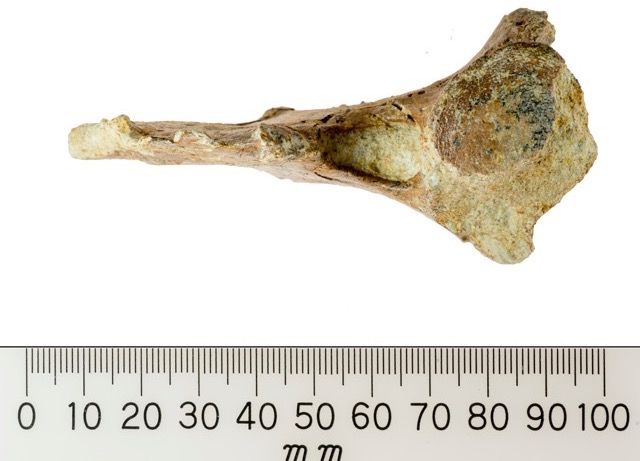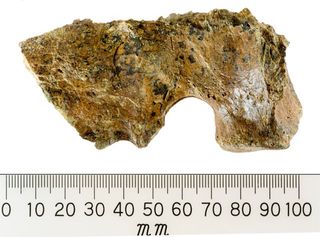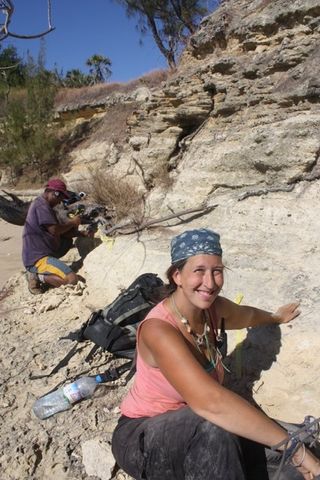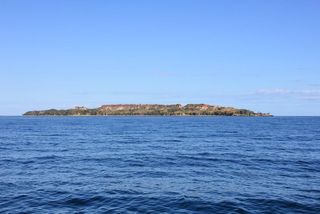First-Ever Madagascar Dolphin Fossil Discovered

A single fossilized backbone is the first evidence on record that dolphins once swam around the waters of ancient Madagascar, scientists say.
The fossil backbone, or vertebra, dates to between 5 million and 9 million years ago during the late Miocene epoch, and belongs to a previously unknown and still unnamed species of dolphin, the researchers said.
"This exciting discovery marks the first fossil cetacean [a group including dolphins, whales and porpoises] from Madagascar," said study lead researcher Karen Samonds, an associate professor of biological sciences at Northern Illinois University. [The World's Biggest Beasts: Here and Gone]

Samonds found the fossilized vertebra on Nosy Makamby, a tiny island off the northwest coast of Madagascar, in 2010. It was ensconced in marine rock by the shore, and it dated to well after the time that Madagascar became an isolated island, Samonds said.
"[The fossil] was a challenge to identify," Samonds told Live Science in an email. "When we discovered it, we could tell that it was a vertebra, and there were various characteristics about its shape that could tell us that we were looking at a mammal."
But the researchers weren't certain what type of mammal it was. The vertebra was relatively long and slender, about 4 inches (10 centimeters) in length and about 2 inches (5.3 cm) wide, "which is unlike most terrestrial or land-dwelling mammals," Samonds said.

After an anatomical analysis, the researchers determined that the vertebra had a robust neural spine, the triangular part of the vertebra that juts out. This remarkable feature indicated that the fossil likely belonged to a dolphin, a mammal that uses its long neural spines to help rhythmically bend its backbone as it swims, Samonds said.
Sign up for the Live Science daily newsletter now
Get the world’s most fascinating discoveries delivered straight to your inbox.
The vertebra's features are similar to those seen in modern river dolphins, including the Amazon River dolphin, or boto, (Inia geoffrensis) and the La Plata River dolphin, or franciscana, (Pontoporia blainvillei), she said.
"The boto and franciscana are riverine or estuarine [estuaries occur where rivers flow into seas], while the Madagascar dolphin was marine," Samonds said. "However, boto and franciscana are the closest likely relatives to the fossil, suggesting that they and the Madagascar dolphin had a common ancestor in [the] western Atlantic region."
It's difficult to say too much about the dolphin based on one fossil vertebra, but the creature likely measured between 5 and 6.5 feet (1.5 to 2 meters) in length, said study co-researcher Ewan Fordyce, a vertebrate paleobiologist at the Univeristy of Otago in New Zealand.
Fordyce said that Madagascar is on his list of places to hunt for fossils; Samonds, on the other hand, has worked there for years, detailing other fossil Malagasy animals, including an ancient juvenile crocodylian detailed in the journal PeerJ and a Miocene-epoch shark described in the journal PLOS ONE. But despite these findings, it's unclear where most of the island's diverse fauna originated, she said.
"One major impediment to our understanding has been the lack of a Cenozoic [65.5 million years ago to present] fossil record, the time period when many animal groups are thought to have arrived [in Madagascar]," Samonds said. "Our work is finally beginning to elucidate this unknown time period."

Nowadays, several types of dolphins swim around Madagascar, including humpback dolphins and Indo-Pacific bottlenose dolphins, according to the Wildlife Conservation Society, a nature conservancy organization in Madagascar.
The study, which has yet to be published in a peer-reviewed journal, was presented Oct. 28 at the 2016 Society of Vertebrate Paleontology meeting in Salt Lake City.
Original article on Live Science.

Laura is the archaeology and Life's Little Mysteries editor at Live Science. She also reports on general science, including paleontology. Her work has appeared in The New York Times, Scholastic, Popular Science and Spectrum, a site on autism research. She has won multiple awards from the Society of Professional Journalists and the Washington Newspaper Publishers Association for her reporting at a weekly newspaper near Seattle. Laura holds a bachelor's degree in English literature and psychology from Washington University in St. Louis and a master's degree in science writing from NYU.











